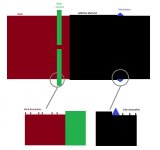trueninjalo
Lifetime Supporting Member
Background
I have a web edge sensor on each side of a fabric web. After adding material to the web, I cut the excess material with knives aligned to the edge of the base fabric by using the web edge sensor readings. There are some small threads and inconsistencies that extend beyond the web edge affecting the knife positioning causing trim anomalies. I had drawn a picture but I am unable to access imagur or photo bucket from our intranet. So I added it as an attachment.
Scope
Use an averaging of the edge senor reading to minimize the effect of the web edge anomalies. Initial thought is to use an array of 50ms scan rates over 5 seconds (REAL[100]) then continuously average this array. A FIFO should be able to do this but is there a better way? Is this the wrong approach? Thoughts are welcome and appreciated.
System Info
Logix Designer 5000 V 28.00
1756-L71
1756-IF16 (slot 6) Web Sensor(left 0,Right 1), Knife position feedback (lower left 2, Lower right 3, Up left 4, up right 5)
1756-OA16I (slot 7) Knife position Servo (Up left Fwd 1, Up Right Rev 2, Up right Fwd 3, Low Left Rev 4, Low left Fwd 5, Low right Rev 6, Low right fwd 7, up left rev 8)
I didn't set this up so don't scream at me for the plug in locations lol

I have a web edge sensor on each side of a fabric web. After adding material to the web, I cut the excess material with knives aligned to the edge of the base fabric by using the web edge sensor readings. There are some small threads and inconsistencies that extend beyond the web edge affecting the knife positioning causing trim anomalies. I had drawn a picture but I am unable to access imagur or photo bucket from our intranet. So I added it as an attachment.
Scope
Use an averaging of the edge senor reading to minimize the effect of the web edge anomalies. Initial thought is to use an array of 50ms scan rates over 5 seconds (REAL[100]) then continuously average this array. A FIFO should be able to do this but is there a better way? Is this the wrong approach? Thoughts are welcome and appreciated.
System Info
Logix Designer 5000 V 28.00
1756-L71
1756-IF16 (slot 6) Web Sensor(left 0,Right 1), Knife position feedback (lower left 2, Lower right 3, Up left 4, up right 5)
1756-OA16I (slot 7) Knife position Servo (Up left Fwd 1, Up Right Rev 2, Up right Fwd 3, Low Left Rev 4, Low left Fwd 5, Low right Rev 6, Low right fwd 7, up left rev 8)
I didn't set this up so don't scream at me for the plug in locations lol

Last edited:



